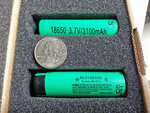George S.
Well-Known Member
There's talk that Tesla wants to build a mega-factory, just for lithium cells. One thing under consideration is to make the cells different from the current standard, which I assume being is used by ebike companies:
In addition, the cells Tesla currently use are a standard model called an 18650. If the company has committed to a unique design from Panasonic, it would presumably be at least a couple of years before it went into use to allow Tesla time for other manufacturers to ramp up production of the design. Even with the new supply agreement, the forthcoming $35,000 sedan some are referring to as the Model E will require perhaps another billion cells annually on its own. The agreement announced today makes no mention of that vehicle.
Seems like the cost benefits of more cells, more capacity, would be higher if everyone was making a standard cell. It's still more capacity. It's a little hard to believe a Tesla has around 6,000 cells about the size of a AA battery.
All the trends are super-positive for ebikes. More capacity at lower cost, one way or another. Everyone wants the battery to weigh less, cost less, and have more range.
http://www.forbes.com/sites/markrog...uggests-sales-could-quintuple-within-4-years/
In addition, the cells Tesla currently use are a standard model called an 18650. If the company has committed to a unique design from Panasonic, it would presumably be at least a couple of years before it went into use to allow Tesla time for other manufacturers to ramp up production of the design. Even with the new supply agreement, the forthcoming $35,000 sedan some are referring to as the Model E will require perhaps another billion cells annually on its own. The agreement announced today makes no mention of that vehicle.
Seems like the cost benefits of more cells, more capacity, would be higher if everyone was making a standard cell. It's still more capacity. It's a little hard to believe a Tesla has around 6,000 cells about the size of a AA battery.
All the trends are super-positive for ebikes. More capacity at lower cost, one way or another. Everyone wants the battery to weigh less, cost less, and have more range.
http://www.forbes.com/sites/markrog...uggests-sales-could-quintuple-within-4-years/
